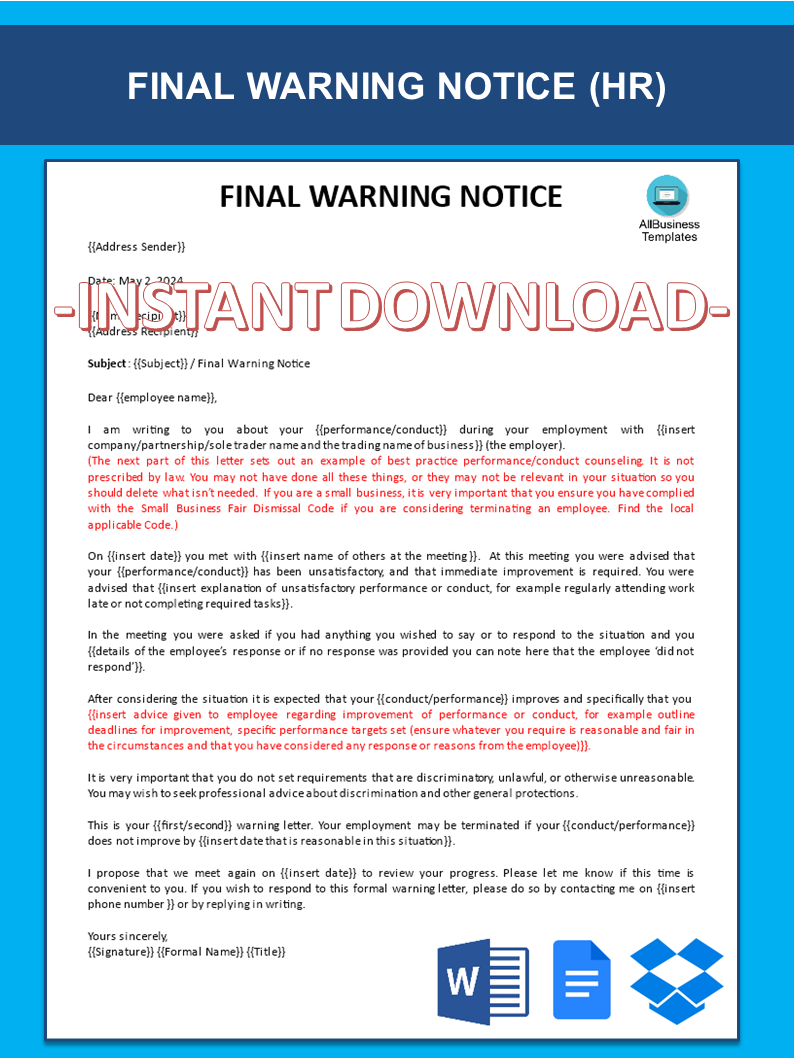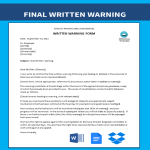Final Employee Warning

Speichern, ausfüllen, drucken, fertig!
How to write an effective employee Warning notice? Download this Final Employee Warning letter template now and modify according to your preferences!
Verfügbare Gratis-Dateiformate:
.docx- Dieses Dokument wurde von einem Professional zertifiziert
- 100% anpassbar
Business Unternehmen HR Personalabteilung warning letter Verwarnungsbrief warning Warnung Letter schreiben employee Mitarbeiter letters briefe Final Finale Insert Einfügen Sample Warning Letter Beispiel Warnschreiben Final Warning Letter Letzter Warnbrief employee final warning template performance improvement warning conduct warning notice last chance warning letter Behavior Warning Letter behavior warning letter template employment final notice hr warning templates poor performance warning job warning notice employee discipline form workplace warning letter final notice before termination employee behavior notice final warning for misconduct warning letter for non performance hr templates for warnings employee warning documentation corrective action notice employment warning letter sample
How to draft a Final Employee Warning? Download this Final Employee Warning template now!
Warning letters are an effective way to address and document performance or conduct issues with an employee. Typically, you issue a warning letter after a meeting where the problem is discussed. This approach is instrumental in resolving issues before they escalate.
While there are no legal mandates for formal written warnings or a specified number of warnings, the Fair Work Commission considers the following to assess if a dismissal was unfair:
- Whether the employee was warned about their performance or conduct issues.
- Whether the employee was given a reasonable opportunity to improve.
- For more guidance, refer to the Best Practice Guide on managing underperformance. If you're uncertain about handling a performance or conduct issue, consulting a lawyer or your employer association is advisable.
Note that in cases of serious misconduct, warnings might not be suitable. In such instances, consider using the Termination of employment (summary dismissal – serious misconduct) template and seek professional advice.
For Small Business Owners:
If you run a small business, adhere to the Small Business Fair Dismissal Code when terminating an employee. Using a structured template letter can help ensure compliance.
Steps to Prepare a Warning Letter:
Step 1: Identify and Analyze the Problem
Define the performance or conduct issue clearly. Consider the severity, duration, and the corrective actions you plan to take.
Step 2: Meet with the Employee
A meeting is crucial to:
- Identify and address issues promptly.
- Set clear expectations.
- Collaborate on solutions for improvement.
- Inform the employee in advance about the meeting's purpose and offer the chance to bring a support person. The Best Practice Guide on managing underperformance provides additional insights into this process.
Step 3: Draft the Warning Letter
Your warning letter should include:
- Use the color-coded warning letter template for guidance, replacing placeholder text with specific details pertinent to your case.
- Start with a clear header: Include the employee's name, the date, and the nature of the document, such as “Written Warning for Poor Peformance”.
- Describe the purpose of the warning: Clearly state that the document is a written warning. This sets the tone and indicates the seriousness of the issue. Specific details of the concern.
- Detail the performance issues: Specify the areas where the employee's performance is lacking. Use specific examples and refer to previous evaluations or incidents. This could include missed deadlines, errors in work, or failure to meet company standards, for example often come too late, or deliver low quality output (mention specific deliverables and costs related bad quality delivered).
- Outline expectations and standards: Clearly describe what is expected from the employee in terms of performance. Be specific about what changes need to be made and what standards must be met moving forward. Thus, the Employer’s commitment to assist is also necessary,
- Provide a plan for improvement: Since it's a final warning, you may offer a plan or suggest steps the employee can take to improve their performance. This might include training, regular check-ins, or specific milestones they need to reach, thus an action plan for the employee is needed.
- Set a timeframe for improvement: A reasonable timeframe for implementing improvements. Specify a reasonable timeframe in which the employee is expected to improve their performance. This creates a sense of urgency and gives a clear timeline for reassessment.
- Explain the consequences: Clearly state the consequences if the employee fails to improve their performance within the specified timeframe. This could include further disciplinary actions up to and including termination. It's therefore important that discussions are held with the employee regarding the issue.
- Offer support: Encourage the employee by letting them know that you are available to help them succeed. Mention any resources or support systems the company has that they can utilize.
- Request a follow-up meeting: Schedule a follow-up meeting to discuss progress. This keeps the lines of communication open and shows the employee that you are invested in their improvement.
- Close with signature lines: Include a place for both the employee and a supervisor or HR representative to sign the warning. This acknowledges that the employee has received and understood the warning.
- Keep it professional and respectful: Throughout the letter, maintain a professional tone. While it's important to be clear and direct about the issues, it’s also crucial to be respectful and avoid overly harsh language.
A written warning is not just a critique—it's also a tool to guide and improve employee performance. Being clear, specific, and supportive can help motivate the employee towards positive changes
Step 4: Deliver the Warning Letter
Ensure the employee receives the letter and document the delivery process. If suitable, have the employee sign the letter as acknowledgment of receipt, though this is not legally required.
Maintaining a copy of the letter in your records is crucial, as is following up to confirm understanding and receipt.
Important: Always document meetings related to performance or conduct issues using the appropriate templates. Avoid setting discriminatory or unreasonable targets or requirements. Seeking professional advice on discrimination and general protections is recommended.
By following these steps and documenting each stage, you protect both the employee's rights and your business interests. Download this Human Resources Final Employee Warning template now!
Also interested in other HR templates? Browse through our database and have instant access to hundreds of free and premium HR documents, HR forms, HR agreements, etc
HAFTUNGSAUSSCHLUSS
Nichts auf dieser Website gilt als Rechtsberatung und kein Mandatsverhältnis wird hergestellt.
Wenn Sie Fragen oder Anmerkungen haben, können Sie sie gerne unten veröffentlichen.

